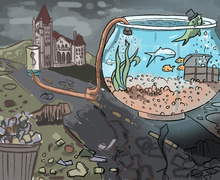Thompson: Backlash to gay character in ‘Beauty and the Beast’ is unwarranted, and unfortunately a tale as old as time
Courtesy of Disney
The release of Walt Disney Co.’s live-action “Beauty and the Beast,” has sparked controversy for its inclusion of LeFou (left, played by Josh Gad), Gaston’s sidekick, who was re-imagined as a gay man.
It’s a tale as old as time, true as it can be: Kidnapping and bestiality are acceptable storylines in children’s films, but two men dancing is not.
Walt Disney Co.’s live-action version of “Beauty and the Beast,” which was released Friday in the United States, is already sparking controversy that doesn’t have to do with Lumière’s candle wicks. The film, a 21st-century adaptation of the 1991 animated movie, re-envisioned the villain Gaston’s sidekick, LeFou, as a gay man.
LeFou, who has made history as Disney’s first LGBTQ character, was re-imagined as gay as a means of paying tribute to the animated film’s late lyricist, Howard Ashman. But some conservatives in the United States and beyond value their personal hypocrisy over the Christian message of respecting all walks of life, and feel that a gay character has no place in a children’s film.
A drive-in movie theater in Henagar, Alabama, took the extreme route and pulled all screenings of the film. The Malaysian government also prevented the release of the movie after Disney refused to cut a scene that involves Gaston and LeFou dancing together, according to The Los Angeles Times. And Russia’s Ministry of Culture made the movie’s rating more severe so that children under the age of 16 can only enter the theater with someone older than 16, per The Times.
A Facebook post from the Henagar Drive-In Theatre — which has since been made unavailable to public viewing — read, per Variety: “We are first and foremost Christians. We will not compromise on what the Bible teaches. We will continue to show family oriented films so you can feel free to come watch wholesome movies without worrying about sex, nudity, homosexuality and foul language.”
In a film that glorifies kidnapping, violence and hints at bestiality, conservatives’ latest whining over a gay character is a prime example of the pot calling the kettle black. In our violence-saturated culture, we have become more tolerant and inviting toward two men pointing pistols at one another rather than holding hands or kissing.
Peggy Droz, an actress and adjunct professor in Syracuse University’s departments of drama and television, radio and film, said Disney’s inclusion of a gay character is a step in the right direction for greater representation, diversity and inclusion within the film industry.
“What it all comes down to is ignorance and a fear of the ‘unknown,’” Droz said in an email. She added that it is essential for children’s films to depict people of a variety of races, ethnicities, religions and sexual orientations.
The fact of the matter is, when we reduce LeFou dancing with another man as merely a gay scene in a montage of straight ones, we continually perpetuate this notion that being gay or queer is something odd — something that straight people can make a spectacle of. It’s time to stop the automatic categorization of LGBTQ affections and romances as “other” when compared to their heterosexual counterparts.
Whether for political reasons or not, Disney’s inclusion of a gay character is a shining moment of progress for a culture that has regressed in acceptance and inclusion under the current American political climate.
Certain as the sun, rising in the east, being unique is nothing to fear.
There must be more than this provincial life.
Kelsey Thompson is a sophomore magazine journalism major. Her column appears weekly. She can be reached at katho101@syr.edu.
Published on March 19, 2017 at 9:30 pm





